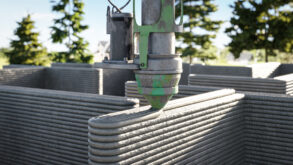
Staying ahead in the construction sector requires embracing innovation—finding smarter, faster and more sustainable methods to build. And right now, one technology that’s definitely making waves and changing the game is 3D printing.
In this article, we’ll look into the impact of 3D printing on construction, how it is reshaping the way we build and what to look out for in the future in terms of this technology.
What is 3D Printing in Construction?
Unlike traditional methods that involve piecing materials together, additive manufacturing—specifically 3D printing—builds objects layer by layer, following a digital blueprint. This process allows for intricate designs and shapes that may be challenging or impractical to achieve through conventional means.
3D Printing in Construction Today
Construction companies are jumping on the 3D printing bandwagon to shake up the way we’ve always built things. The global 3D construction printing market hit $18 million in 2022, and is expected to accelerate. Companies like COBOD International and Yingchuang Building Technique (WinSun) are leading the charge, pushing the boundaries of large-scale 3D printing. COBOD’s printers alone have worked their magic on almost 40% of all 3D construction projects worldwide, churning out 51 buildings.
Advantages of 3D Printing in Construction
Here are the significant advantages of this technology in construction.
Construction Timelines
One big plus of 3D printing? Speed. According to a report from McKinsey & Company, this tech can slash construction time by as much as 50%, all while keeping quality top-notch. That means not only saving cash but also giving clients, investors and real estate fund managers a faster route to boosting profits from residential investment properties.
A prime example of this time-saving advantage is the construction of a 3D-printed “Office of the Future” in Dubai, considered the world’s first fully functioning 3D building. Printing and installation took 19 days, and the building services, interiors and landscape work took around three months. Moreover, this approach notably cuts labor costs compared to traditional buildings of similar size.
Cost-Effectiveness and Sustainability
When it comes to costs, 3D printing is a step change. According to a report by Deloitte, integrating 3D printing into construction could slash expenses by up to 50%. By cutting down on material waste and slashing labor costs typically associated with traditional methods, 3D printing proves itself as a cost-effective option.
The use of recycled materials in 3D printing is another factor contributing to its cost-effectiveness and sustainability. 3D printers can work with recycled plastics, concrete and other materials, reducing waste and environmental impact.
Design Freedom and Customization
3D printing provides design freedom and customization options. Unlike cookie-cutter designs, this technology offers endless possibilities for customization. Whether it’s intricate architectural details or one-of-a-kind shapes, builders can bring their unique visions to life with precision and ease.
Companies like Branch Technology have been at the forefront of leveraging 3D printing to create complex, high-functioning and completely customized designs in the construction industry. Branch Technology’s patented Cellular Fabrication (C-Fab) process enables them to 3D print open-lattice structures that can take on virtually any shape or form, offering unprecedented design freedom.

Structural Strength and Durability
Despite common misconceptions, 3D-printed structures are not only innovative but also remarkably durable. CyBe Mortar, an earthquake-resistant concrete specifically formulated for 3D printing, combines high-strength aggregates and fibers, enhancing its ability to withstand seismic forces.
Thanks to advanced materials and construction techniques, these buildings meet or even exceed traditional standards for strength and longevity.
Overcoming Challenges
3D printing brings a lot to the table, but it’s not without its challenges. Here are a few we need to tackle head-on:
Budget
The upfront costs for 3D printing equipment, materials and training can be steep, but it’s an investment for the long haul. Over time, the thinking goes, savings add up, making it worth the initial expense.
Selection of Materials
Currently, the options for 3D printing materials are a bit limited. However, advancements in tech are expanding our choices. Soon enough, we expect custom-engineered materials to fit any job.
Workforce Skills and Training
As 3D printing tech evolves at top speed, we need a workforce that can keep up. That means investing in training programs and forging partnerships with experts. As an immediate alternative, contractors may outsource certain parts of a project.
A Look into the Future
Looking ahead, the future of 3D printing in construction is promising, with the potential to transform how we build structures and infrastructure. By 2025, industry observers estimate that 70% of new commercial and residential construction projects will involve some form of 3D printing technology. The global construction 3D printing market is projected to reach $40.5 billion by 2027, according to market research
Technological Advancements
Expect ongoing advancements in 3D printing technology, bringing faster printing speeds, better precision and improved scalability. Innovations like robotic arms, autonomous construction systems, and the ability to print with multiple materials will open up new possibilities for creating intricate and sustainable structures while keeping costs down.
Sustainability
3D printing has the power to slash construction waste by up to 30%, as per the U.S. National Institute of Standards and Technology. When we opt for eco-friendly materials, use less energy, and waste less, 3D printing becomes a key player in promoting environmentally friendly building practices—taking small steps to reduce the construction industry’s impact on the environment.
Integration
In the future, we’re going to see 3D printing teaming up with digital tech like BIM, augmented reality and virtual reality. These digital tools will completely change the way we work together, visualize projects and manage them.
Edrian Blasquino is a college instructor and writer.

Discussion
Be the first to leave a comment.
You must be a member of the BuiltWorlds community to join the discussion.